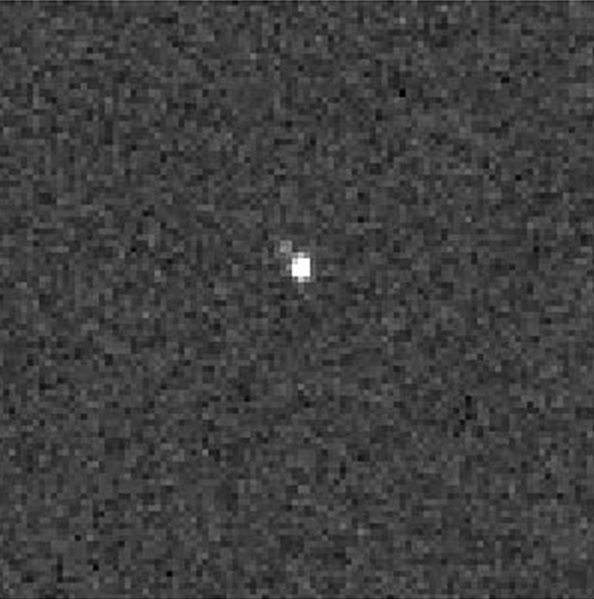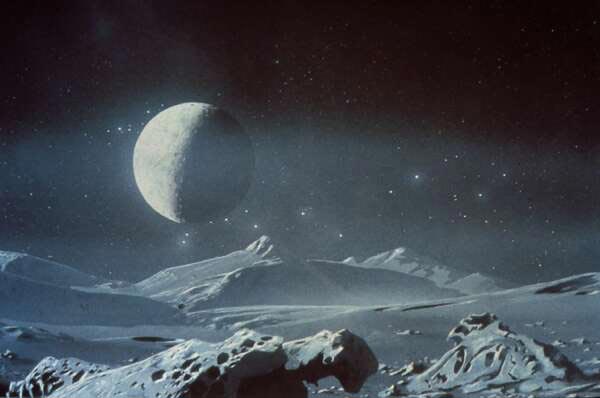
The two bright clusters of pixels in the image above might not seem like much of a big deal, but they are… those two blocky blobs are the dwarf planet Pluto and its largest moon, Charon, as seen by the rapidly-approaching New Horizons spacecraft, destined for its ultimate close encounter in July 2015!
This represents a major milestone on the spacecraft’s 9½-year journey to conduct humanity’s first close-up reconnaissance of the Pluto system and the Kuiper Belt and, in a sense, begins the mission’s long-range study of the Pluto system.
And that’s a very big deal indeed. Read on, fellow space fans…
The largest of Pluto’s five known moons, Charon (pronounced kair-un) orbits about 12,000 miles (more than 19,000 kilometers) away from Pluto. As seen from New Horizons, that’s only about 0.01 degrees of spatial separation — that’s a hundred times smaller than the width of your little finger held at arm’s length!
“The image itself might not look very impressive to the untrained eye, but compared to the discovery images of Charon from Earth, these ‘discovery’ images from New Horizons look great!” says New Horizons Project Scientist Hal Weaver, of the Johns Hopkins University Applied Physics Laboratory. “We’re very excited to see Pluto and Charon as separate objects for the first time from New Horizons.”
The spacecraft was still 550 million miles from Pluto – farther than the distance from Earth to Jupiter – when its LOng Range Reconnaissance Imager (LORRI) snapped a total of six images: three on July 1 and three more on July 3. LORRI’s excellent sensitivity and spatial resolution revealed Charon at exactly the predicted offset from Pluto, 35 years after the announcement of Charon’s discovery in 1978 by James Christy of the Naval Observatory.
“We’re excited to have our first pixel on Charon, but two years from now, near closest approach, we’ll have almost a million pixels on Charon –and I expect we’ll be about a million times happier too!”
– Alan Stern, New Horizons Principal Investigator, SwRI
At just about 750 miles ( 1207 km) wide, Charon is almost half the size of Pluto. In fact it’s so big in comparison that Pluto and Charon are often referred to as a double-dwarf planet system. The distance between them is a mere 12,200 miles (19,640 km)… compare that to the ~240,000 miles that separate our Moon from us!
If Charon were orbiting Earth at the same distance as it does Pluto, it would be as far away as GPS satellites (and much closer than geostationary weather and comm sats.)

Charon’s orbit around Pluto takes 6.4 Earth days, and one Pluto rotation (a Pluto day) takes 6.4 Earth days, meaning Charon neither rises nor sets but rather hovers over the same spot on Pluto’s surface. The same side of Charon always faces Pluto in an effect called tidal locking. Compared with most of the planets and moons, the Pluto-Charon system is tipped on its side, like Uranus. Also like Uranus (and Venus) Pluto’s rotation is retrograde: it rotates backwards, from east to west.
Pluto has a total of 5 known moons: Charon, Hydra, Nix, and the recently-named Styx and Kerberos.
Top image: NASA/Johns Hopkins University Applied Physics Laboratory/Southwest Research Institute
Very cool!
I have heard Neil Desgrasse Tyson speak about planets that are to close to one another, and how it alters their orbit around their star. Is this a factor with Charon and Pluto since Charon is so large?
LikeLike
Pluto/Charon’s orbit around the Sun is stable, but they are so large compared to each other that they orbit a central point (barycenter) outside of Pluto’s own radius. It’s almost like who’s the moon of whom!
LikeLike
Ah, tidal locking! 🙂 Awesome!
LikeLike
Wow, wow, wow!
LikeLike